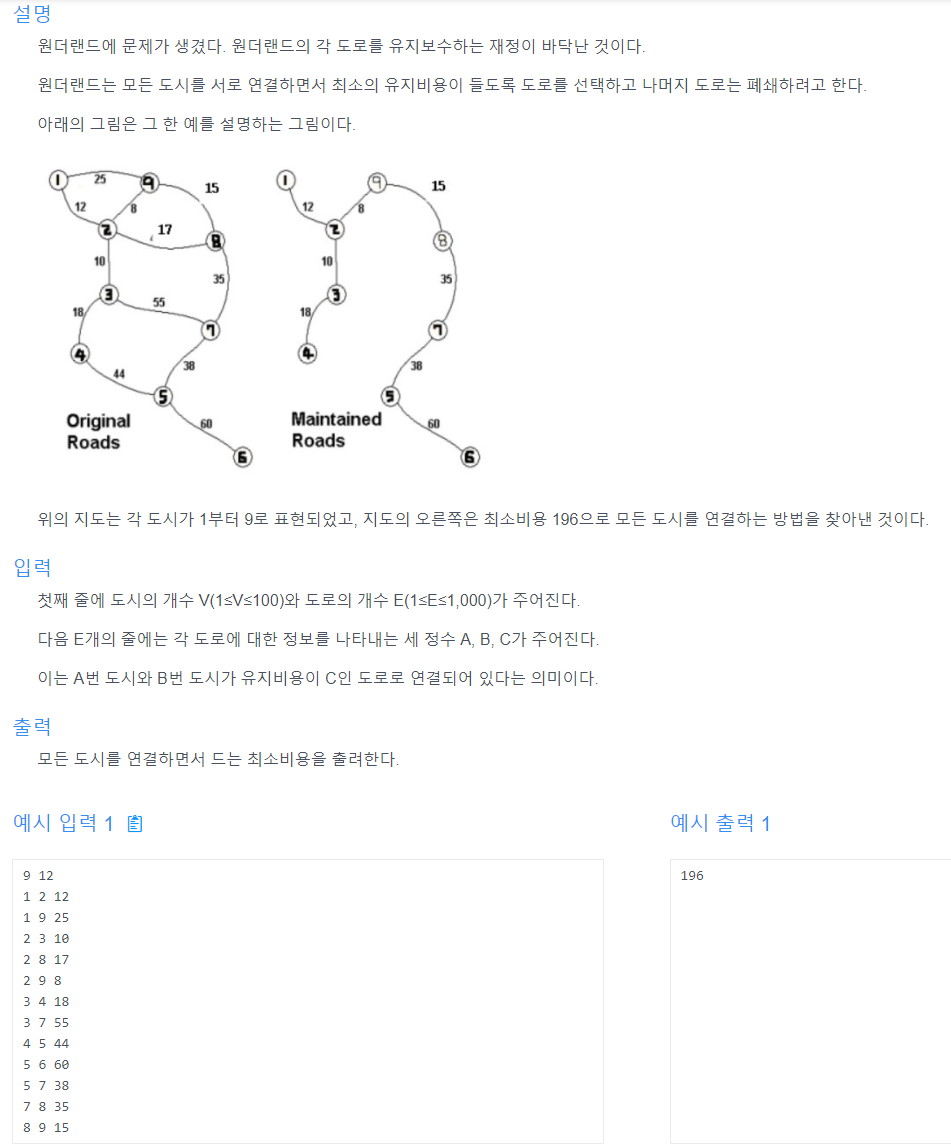문제

풀이
- 정렬 + 유니온 파인드 문제
- 준비물 :
- parent : 도시(정점)을 담을 배열
- Edge : 간선과 비용의 정보를 탐을 클래스
- union, find : 유니온 파인드 구현체 및 기본 지식
- 회로를 그리되 최소 비용을 구해야 하므로 Edge 클래스 배열을 만든다
- 최소 비용을 구하므로 cost 오름 차순으로 정렬한다.
- Edge 배열의 각 두 정점의 부모가 같은지 확인한다.
- 같다면 연결되어 있는거고 아니면 비용을 추가하고 합쳐준다.
- 끗
잡담
그래프는 회로가 존재하고, 트리는 절대 회로가 존재하지 않는다.
간선의 수 = 정점의 수 - 1
전체 코드
package inflearn;
import java.util.ArrayList;
import java.util.Collections;
import java.util.Scanner;
public class I0907 {
static int[] parent;
public static void main(String[] args) {
Scanner sc = new Scanner(System.in);
int v = sc.nextInt();
int e = sc.nextInt();
parent = new int[v + 1];
ArrayList<Edge> arr = new ArrayList<>();
// 정점 초기화
for (int i = 1; i <= v; i++) {
parent[i] = i;
}
// 간선과 비용 초기화
for (int i = 0; i < e; i++) {
int v1 = sc.nextInt();
int v2 = sc.nextInt();
int cost = sc.nextInt();
arr.add(new Edge(v1, v2, cost));
}
System.out.println(solution(arr));
}
static int solution(ArrayList<Edge> arr) {
int ans = 0;
// 클래스에서 정의해둔 compareTo 방식으로 정렬한다. cost 오름차순
Collections.sort(arr);
// 두 정점의 부모 노드가 다를 때, 즉 서로 연결이 안 되어 있을 때 값을 추가한다.
for (Edge n : arr) {
if (find(n.v1) != find(n.v2)) {
ans += n.cost;
// 추가했으므로 두 정점은 합쳐준다.
union(n.v1, n.v2);
}
}
return ans;
}
// 파인드 구현체
static int find(int r) {
// 부모라면 반환
if (parent[r] == r) return r;
// 재귀로 부모를 찾아간다.
return parent[r] = find(parent[r]);
}
// 유니온 구현체
static void union(int e1, int e2) {
// e1, e2의 부모 노드를 찾아서 비교한다.
int a = find(e1);
int b = find(e2);
// 부모 노드가 같다면 합쳐진 상태이므로 return
if (a == b) return;
// 큰 값이 작은 값 밑으로 들어간다.
if (a < b) parent[b] = a;
else parent[a] = b;
}
// 간선과 비용 정보를 담을 class
static class Edge implements Comparable<Edge> {
int v1, v2, cost;
public Edge(int v1, int v2, int cost) {
this.v1 = v1;
this.v2 = v2;
this.cost = cost;
}
@Override
public int compareTo(Edge o) {
return cost - o.cost;
}
}
}
